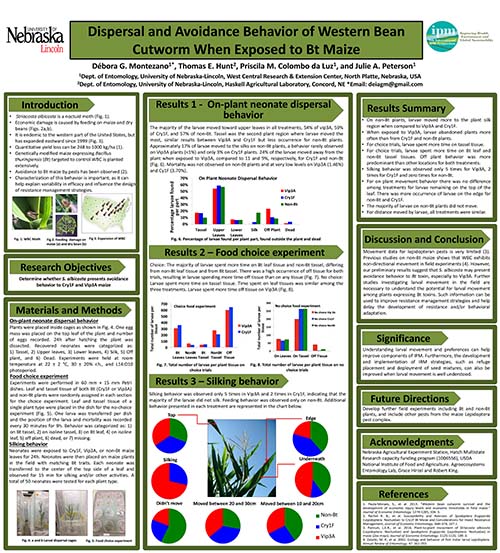"Knowledge and tools to combat western bean cutworm: an emergent and adaptive pest in North American maize" symposium was held on 21 March 2018 at the 9th International Integrated Pest Managment Symposium in Baltimore, MD.
Symposium Goals:
- improve understanding of the IPM issues surrounding WBC
- increase collaborations among multistate research and extension communities by bringing together and sharing knowledge, skills, and tools to increase adoption of effective IPM practices for WBC
The symposium program included six invited presentations and a concurrent poster and extension materials session, and involved WBC researchers from across the United States, Canada, and Mexico. During the poster and extension materials sections, several participants were interviewed by Rosemary Hallberg, Communications Director at the Southern Region IPM Center in Raleigh, NC.
Presentations
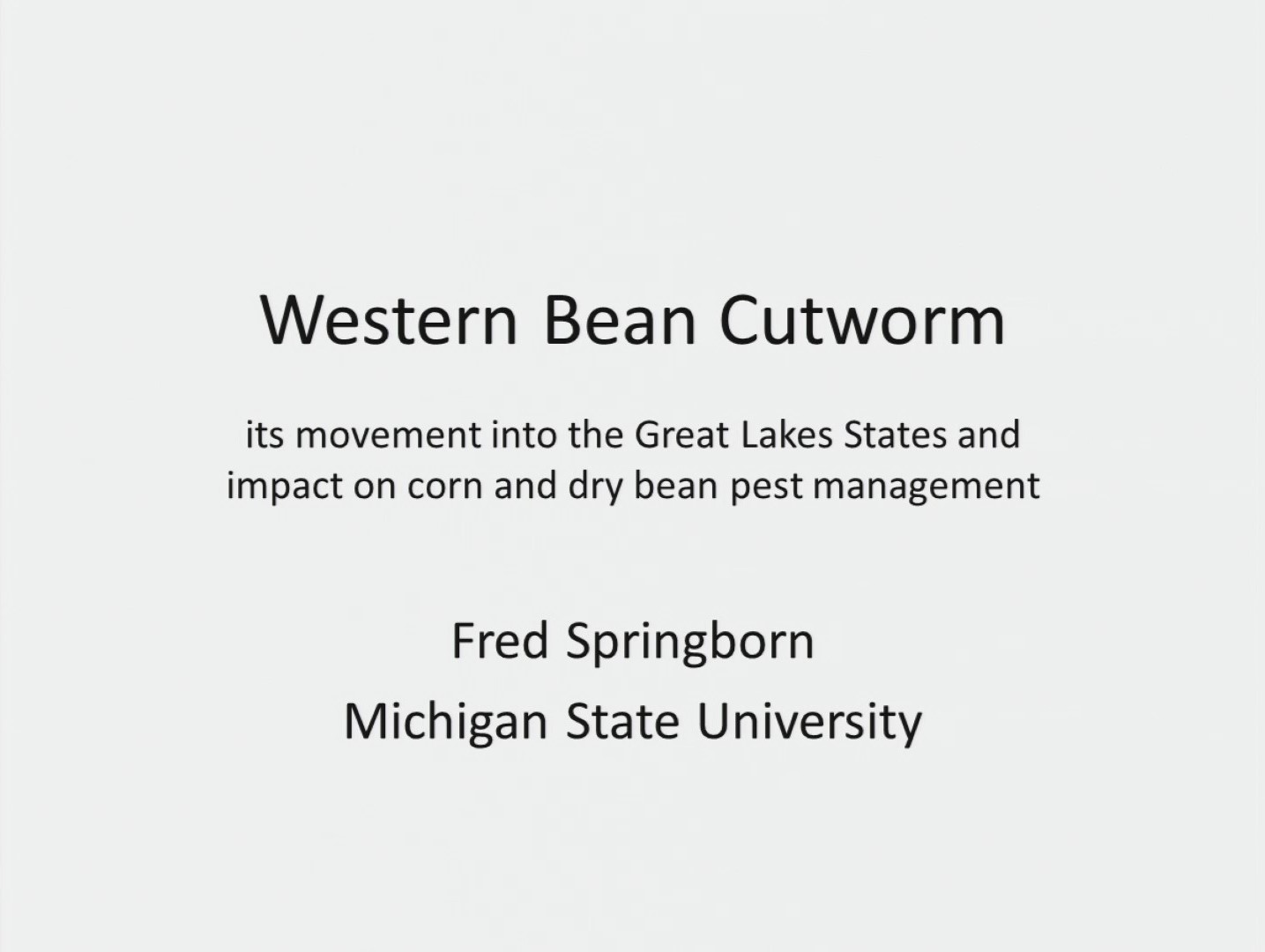
Western bean cutworm, its movement into the Great Lakes States and impact on corn and dry bean pest management
Fred Springborn1 and Christina D. DiFonzo2 1MSU Extension, Michigan State University, Stanton, MI 2Department of Entomology, Michigan State University, East Lansing, MI
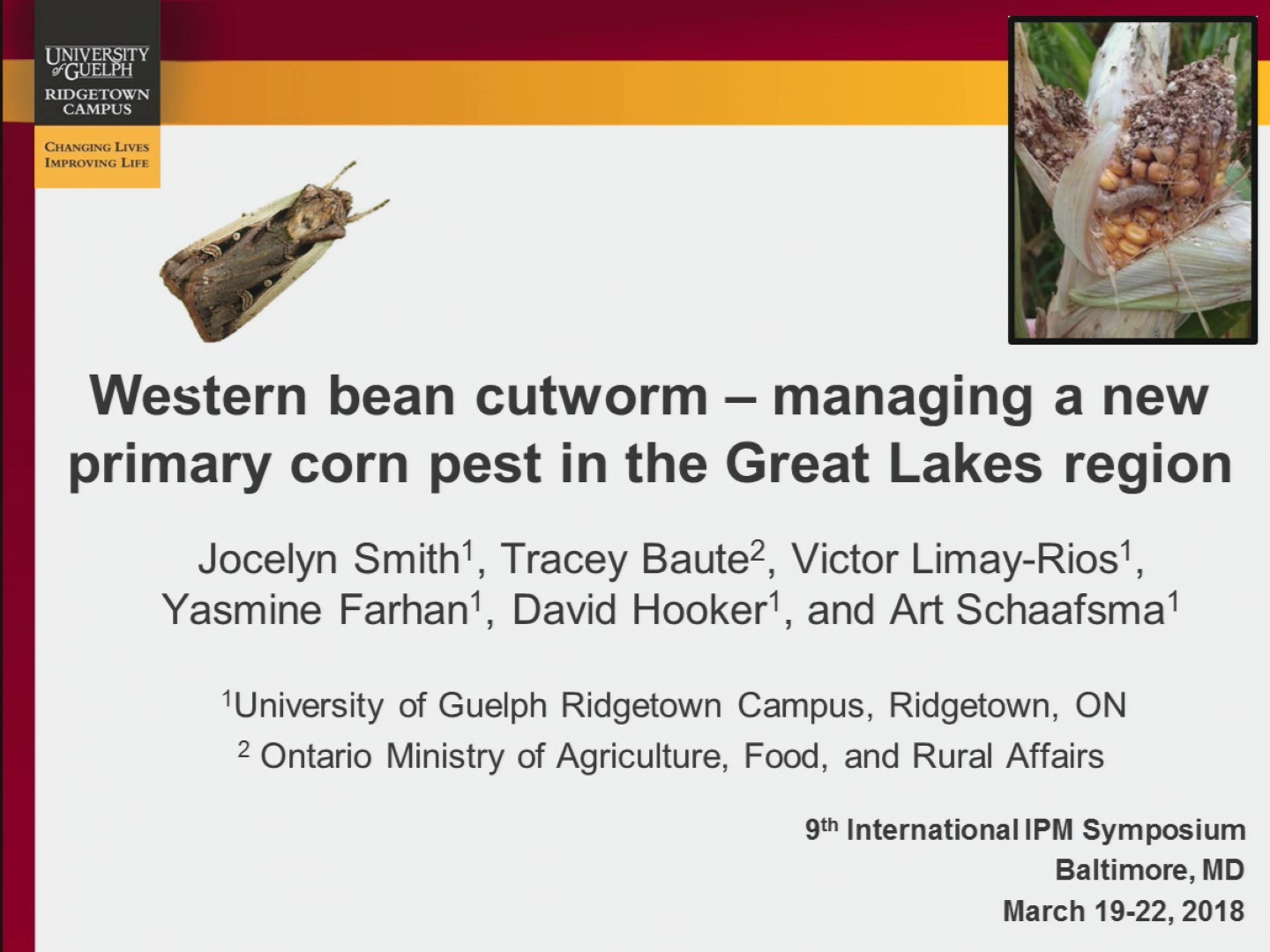
Management of western bean cutworm in Ontario, Canada
Jocelyn Smith, Victor Limay-Rios, Yasmine Farhan, David Hooker, and Art
Schaafsma
University of Guelph Ridgetown Campus, Guelph, Ontario, Canada
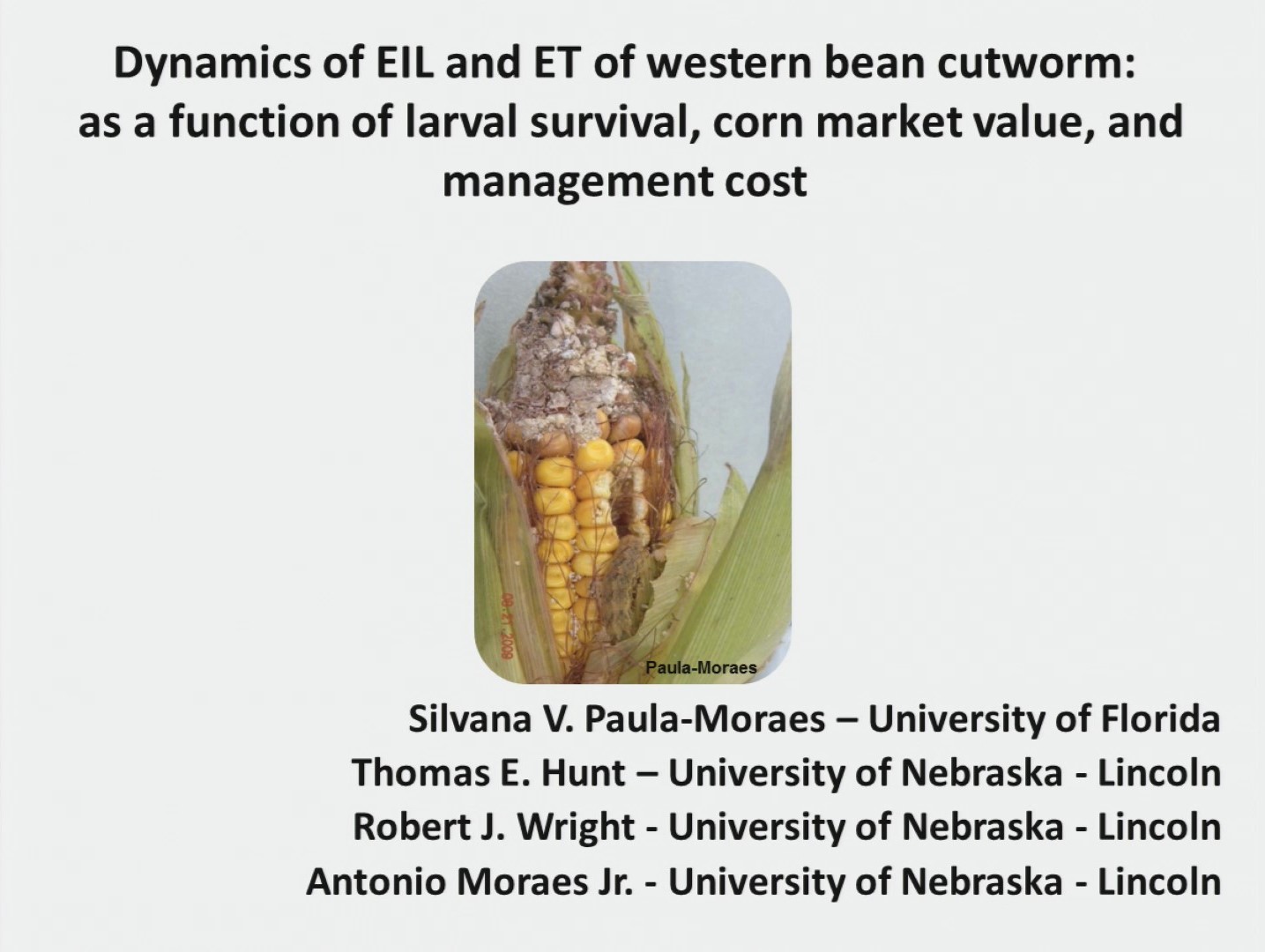
Dynamics of EIL and ET of western bean cutworm as a function of larval survival, corn market value, and management cost
Silvana V. Paula-Moraes1, Thomas E. Hunt2, Robert J.
Wright3, and Antonio R. Moraes Jr.4
1Entomology &
Nematology Department, West Florida Research and Education Center, IFAS University of Florida,
Jay, FL
2Department of Entomology, University of Nebraska-Lincoln, Haskell Agricultural
Laboratory, Concord, NE
3Department of Entomology, University of Nebraska-Lincoln, Lincoln, NE
4Department of Agriculture Economics, University of Nebraska-Lincoln, Lincoln, NE
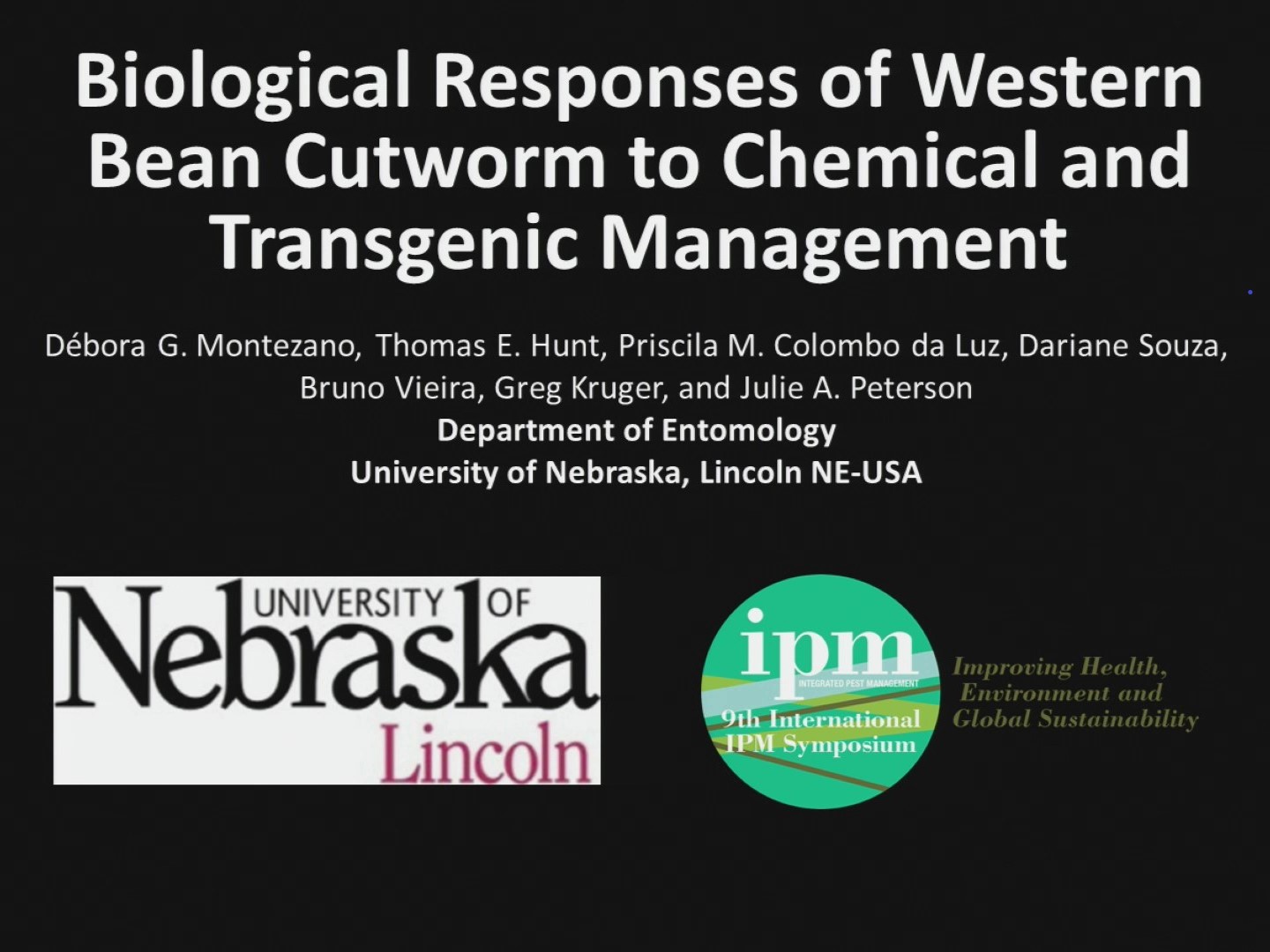
Biological responses of western bean cutworm to chemical and transgenic management
Débora G. Montezano1, Thomas E. Hunt2, Priscila M.
Colombo da Luz3, Dariane Souza1, Bruno Vieira4, Greg
Kruger4, and Julie A. Peterson3
1Department of Entomology,
University of Nebraska-Lincoln, Lincoln, NE
2Department of Entomology, University of Nebraska-Lincoln, Haskell Agricultural
Laboratory, Concord, NE
3Department of Entomology, University of Nebraska-Lincoln, West Central Research and
Extension Center, North Platte, NE
4Department of Agronomy and Horticulture, University of Nebraska-Lincoln, West
Central Research and Extension Center, North Platte, NE

Monitoring Cry1Fa toxin resistance levels among western bean cutworm populations
Brad S. Coates1, Yangzhou Wang1,2, Sarah N.
Zukoff3, Tom E. Hunt4, and Julie A.
Peterson5
1USDA-ARS, Corn Insects & Crop Genetics Research Unit,
Ames, IA
2Jilin Academy of Agricultural Sciences, Changchun, China
3Department of Entomology, Kansas State University, Southwest Research and Extension
Center, Garden City, KS
4Department of Entomology, University of Nebraska-Lincoln, Haskell Agricultural
Laboratory, Concord, NE
5Department of Entomology, University of Nebraska-Lincoln, West Central Research and
Extension Center, North Platte, NE

Harnessing the power of predators and parasitoids to incorporate biological control into western bean cutworm IPM
Julie A. Peterson1, Westen R. Archibald1,2, Jeffrey
D. Bradshaw3, Débora G. Montezano4, Priscila Colombo da Luz1,
Katharine A. Swoboda Bhattarai1, and Robert J.
Wright4
1Department of Entomology, University of Nebraska-Lincoln, West
Central Research and Extension Center, North Platte, NE
2Current affiliation: Medical Service Corp, US Navy, Norfolk, VA
3 Department of Entomology, University of Nebraska-Lincoln, Panhandle Research and
Extension Center, Scottsbluff, NE
4Department of Entomology, University of Nebraska-Lincoln, Lincoln, NE
Poster Session
Authors
Débora G. Montezano, Department of Entomology, University of Nebraska-Lincoln, Lincoln, NEPriscila M. Colombo da Luz, Department of Entomology, University of Nebraska-Lincoln, West Central Research and Extension Center, North Platte, NE
Thomas E. Hunt, Department of Entomology, University of Nebraska-Lincoln, Haskell Agricultural Laboratory, Concord, NE
Julie A. Peterson, Department of Entomology, University of Nebraska-Lincoln, West Central Research and Extension Center, North Platte, NE
Authors
Scott B. Williams, Chad Aeschliman, and Johnny Park Spensa Technologies, West Lafayette, INAuthors
Katharine A. Swoboda Bhattarai,Department of Entomology, University of Nebraska-Lincoln, West Central Research and Extension Center, North Platte, NEWesten R. Archibald, Department of Entomology, University of Nebraska-Lincoln, West Central Research and Extension Center, North Platte, NE & Current affiliation: Medical Service Corp, US Navy, Norfolk, VA
Douglas B. Jones, Monsanto Company, Lincoln, NE
3, Robert J. Wright, Department of Entomology, University of Nebraska-Lincoln, Lincoln, NE
Julie A.Peterson, Department of Entomology, University of Nebraska-Lincoln, Lincoln, NE
Authors
Sergio R. Sanchez-Peña, Moisés Felipe-Victoriano, and Renato Villegas-Luján, Universidad Autónoma Agraria Antonio Narro, Saltillo, MexicoAuthors
Camila Oliveira-Hofman, Department of Entomology, University of Nebraska-Lincoln, Lincoln, NELance J. Meinke, Department of Entomology, University of Nebraska-Lincoln, Lincoln, NE
Anthony O. Adesemoye, Department of Plant Pathology, University of Nebraska-Lincoln, West Central Research and Extension Center, North Platte, NE
J. A. Peterson, Department of Entomology, University of Nebraska-Lincoln, West Central Research and Extension Center, North Platte, NE
Authors
Priscila M. Colombo da Luz, Department of Entomology, University of Nebraska-Lincoln, West Central Research and Extension Center, North Platte, NEKatharine A. Swoboda Bhattarai, Department of Entomology, University of Nebraska-Lincoln, West Central Research and Extension Center, North Platte, NE
Débora G. Montezano, Department of Entomology, University of Nebraska-Lincoln, Lincoln, NE
T. E. Hunt, Department of Entomology, University of Nebraska-Lincoln, Haskell Agricultural Laboratory, Concord, NE
3, R. J. Wright, Department of Entomology, University of Nebraska-Lincoln, Lincoln, NE
2, and Julie A. Peterson, Department of Entomology, University of Nebraska-Lincoln, West Central Research and Extension Center, North Platte, NE
Authors
Anthony A. Hanson, Department of Entomology, University of Minnesota, St Paul, MNRoger D. Moon, Department of Entomology, University of Minnesota, St Paul, MN
Robert J. Wright, Department of Entomology, University of Nebraska-Lincoln, Lincoln, NE
Thomas E. Hunt, Department of Entomology, University of Nebraska-Lincoln, Haskell Agricultural Laboratory, Concord, NE
William D. Hutchison, Department of Entomology, University of Minnesota, St Paul, MN
Authors
Brad S. Coates, USDA-ARS, Corn Insects & Crop Genetics Research Unit, Ames, IASarah N. Zukoff, Department of Entomology, Kansas State University, Southwest Research and Extension Center, Garden City, KS
Thomas E. Hunt, Department of Entomology, University of Nebraska-Lincoln, Haskell Agricultural Laboratory, Concord, NE
Julie A. Peterson, Department of Entomology, University of Nebraska-Lincoln, West Central Research and Extension Center, North Platte, NE
Authors
Thiago L. M. Fanela, Department of Plant Production, São Paulo State University, São Paulo, BrazilDébora G. Montezano, Department of Entomology, University of Nebraska-Lincoln, Lincoln, NE
Julie A. Peterson, Department of Entomology, University of Nebraska-Lincoln, West Central Research and Extension Center, North Platte, NE
Thomas E. Hunt, Department of Entomology, University of Nebraska-Lincoln, Haskell Agricultural Laboratory, Concord, NE
Authors
Westen R. Archibald, Department of Entomology, University of Nebraska-Lincoln, Lincoln NE & Current affiliation: Medical Service Corp, US Navy, Norfolk, VAJeffrey D. Bradshaw, Department of Entomology, University of Nebraska-Lincoln, Panhandle Research and Extension Center, Scottsbluff, NE
Douglas A. Golick, Department of Entomology, University of Nebraska-Lincoln, Lincoln NE
Robert J. Wright, Department of Entomology, University of Nebraska-Lincoln, Lincoln NE
1, and Julie A. Peterson, Department of Entomology, University of Nebraska-Lincoln, West Central Research and Extension Center, North Platte, NE
Authors
Samantha R. Daniel, Department of Entomology, University of Nebraska-Lincoln, Lincoln NERobert J. Wright, Department of Entomology, University of Nebraska-Lincoln, Lincoln NE
Julie A. Peterson, Department of Entomology, University of Nebraska-Lincoln, West Central Research and Extension Center, North Platte, NE
Authors
Ken Wise, NYS IPM Program, Cornell University, Geneva, NYMarion Zuefle, NYS IPM Program, Cornell University, Geneva, NY
Dan Olmstead, NYS IPM Program, Cornell University, Geneva, NY
Ryan Parker, NYS IPM Program, Cornell University, Geneva, NY
Keith Waldron, NYS IPM Program, Cornell University, Geneva, NY
Carol MacNeil, Cornell Vegetable Program, CCE Ontario County, Canandaigua, NY
Authors
Abby J. Seaman, New York State Integrated Pest Management Program, Cornell University, New York State Agricultural Experiment Station, Geneva, NYJeffrey Gardner, Department of Entomology, Cornell University, Ithaca, NY
Extension Materials Session
Introduction to the Handy Bt Trait Table
The Handy Bt Trait Table (authored by Chris DiFonzo of Michigan State University, Pat Porter of Texas A&M University, and Kelley Tilmon of The Ohio State University) lists the types of Bt traits present in all of the corn hybrids sold in the United States. The table includes the trade names of hybrids with Bt traits, Bt event, protein(s) expressed, herbicide traits, and target insect species.
- Interview with Bob Wright
- How to Use the Handy Bt Trait Table by Chris DiFonzo at Michigan State University
- Handy Bt Trait Table Webpage with a link to the most up-to-date version of the table
Introduction to Scouting and Making Treatment Decisions for WBC
Scouting for WBC egg masses (composed of white, dome-shaped eggs) should begin when the first adults are caught. Control decisions should be made shortly after the moth flight peaks, which is usually in early to mid-July. Several resources are available to help you effectively scout for WBC egg masses and to make treatment decisions.
- Interview with Silvana Paula-Moraes
- Scouting and Making Treatment Decisions for WBC by Silvana Paula-Moraes at University of Florida
- EC 1585 - Western Bean Cutworm Speed Scouting Spreadsheet
- The Western Bean Cutworm Speed Scout App allows users to speed scout corn fields and determine whether WBC populations have reached the action threshold for treatment. The free app is available for iPhone, iPad, iPod Touch, and Android devices and can be downloaded from the Apple App Store or Google Play by searching for "western bean cutworm."
Introduction to the WBC NebGuide
This NebGuide from UN-L Extension addresses the life cycle, scouting, and treatment of WBC in corn and dry beans.
